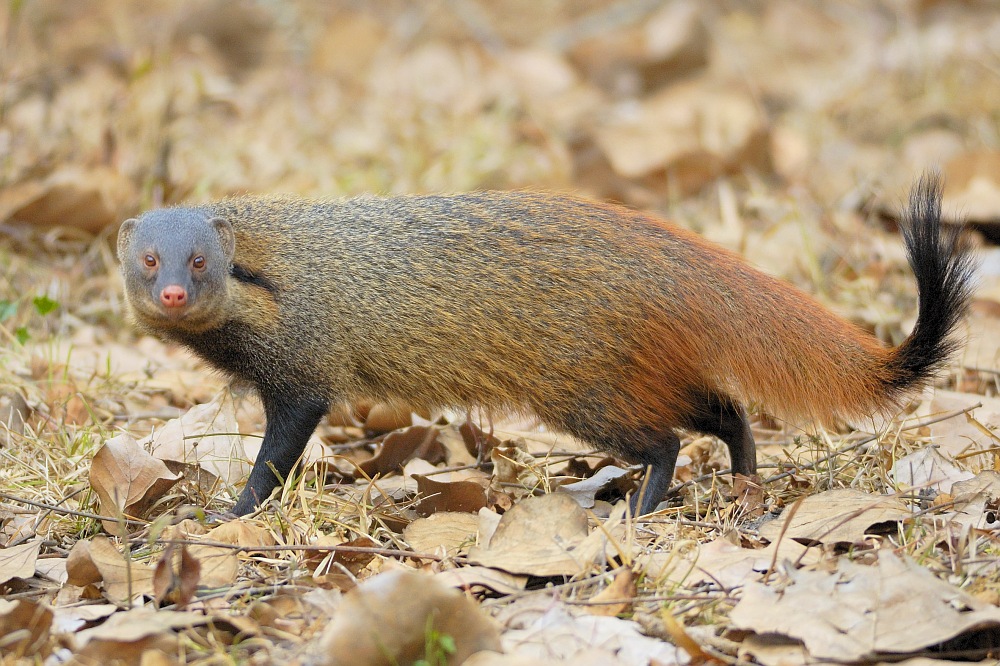How Many Species of Mongoose ?
Introduction:
The mongoose is a family of small to medium-sized carnivores found in Africa, Asia, and southern Europe. There are about 34 different species of mongooses, and they belong to the family Herpestidae. These animals are known for their agility, keen senses, and the ability to prey on venomous snakes.
One notable species is the Indian gray mongoose (Herpestes edwardsii), which is commonly found in India and parts of Southeast Asia. This mongoose has a sleek, grayish-brown fur coat and is known for its adeptness in hunting snakes. It has a well-developed sense of smell and sharp claws, making it a formidable predator.
Species of mongoose:
There are 34 different species of mongoose, belonging to the family Herpestidae. Some of the well-known species include:
Indian Grey Mongoose (Herpestes edwardsii):
Taxonomy:
- Kingdom: Animalia
- Phylum: Chordata
- Class: Mammalia
- Order: Carnivora
- Family: Herpestidae
- Genus: Herpestes
- Species: Herpestes edwardsii
Information:
- The Indian Grey Mongoose is a species of mongoose native to the Indian subcontinent.
- It is also known as the common grey mongoose or the small Indian mongoose.
- The fur of this mongoose is grizzled grey, giving it the common name “grey mongoose.”
- It has a sleek and slender body, with a bushy tail that often has a white tip.
- Indian Grey Mongooses are primarily insectivores, but they also eat small mammals, birds, and eggs.
- They are adaptable and can be found in a variety of habitats, including forests, grasslands, and agricultural areas.
- Known for their agility and ability to kill venomous snakes, they are often considered beneficial in controlling pest populations.
- They are crepuscular, meaning they are most active during dawn and dusk.
The Indian Grey Mongoose is a fascinating species that plays a role in the ecological balance of its habitat by helping control populations of various pests.

Ruddy Mongoose (Herpestes smithii):
Taxonomy:
- Kingdom: Animalia
- Phylum: Chordata
- Class: Mammalia
- Order: Carnivora
- Family: Herpestidae
- Genus: Herpestes
- Species: Herpestes smithii
Information:
- The Ruddy Mongoose, also known as the Indian Brown Mongoose, is a species of mongoose found in the Indian subcontinent.
- The fur of the Ruddy Mongoose is typically a reddish-brown color, which gives it the common name “Ruddy.”
- It has a slender body, a pointed snout, and a long bushy tail.
- Ruddy Mongooses are primarily carnivorous and feed on a variety of prey, including insects, small mammals, birds, and eggs.
- They are agile and are known for their ability to climb trees.
- The species is adaptable and can be found in a range of habitats, including forests, grasslands, and agricultural areas.
- Ruddy Mongooses are often solitary, and they are more active during the day, unlike some other mongoose species that are crepuscular.
- They play a role in controlling pest populations and are valued for their ability to hunt snakes.
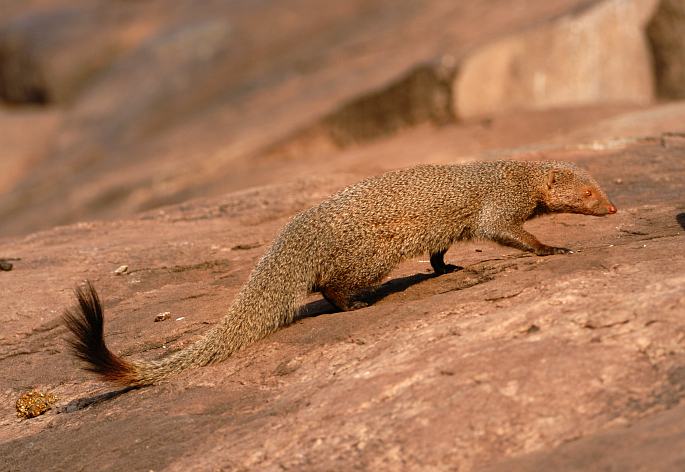
Egyptian Mongoose (Herpestes ichneumon):
Taxonomy:
- Kingdom: Animalia
- Phylum: Chordata
- Class: Mammalia
- Order: Carnivora
- Family: Herpestidae
- Genus: Herpestes
- Species: Herpestes ichneumon
Brief Information:
- The Egyptian Mongoose, also known as the ichneumon, is a species of mongoose found in North Africa and parts of the Middle East.
- It has a slender and elongated body, a pointed snout, and a bushy tail.
- The fur of the Egyptian Mongoose is typically grizzled grey or yellowish-brown, and it has a lighter facial mask.
- These mongooses are known for their diurnal (daytime) activity, and they are often found near water sources.
- Egyptian Mongooses are opportunistic feeders, consuming a varied diet that includes insects, small mammals, birds, reptiles, and eggs.
- They are skilled hunters and are known to tackle venomous snakes, showing a resistance to snake venom.
- The Egyptian Mongoose is a good swimmer and is often observed in aquatic habitats.
- These mongooses may be solitary or live in small groups, and they are territorial.
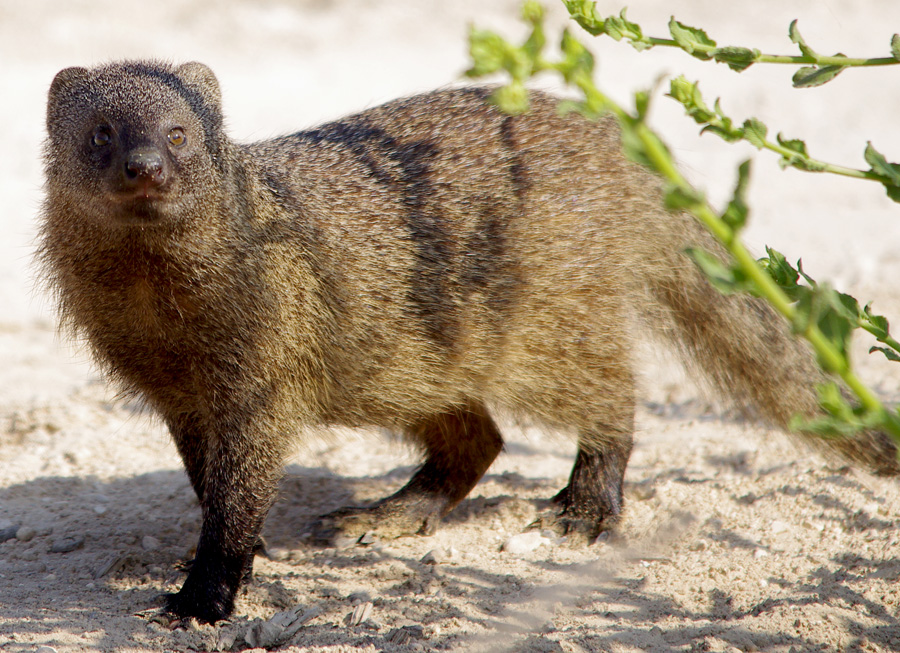
Slender Mongoose (Galerella sanguinea):
- Kingdom: Animalia
- Phylum: Chordata
- Class: Mammalia
- Order: Carnivora
- Family: Herpestidae
- Genus: Galerella
- Species: sanguinea
Short Information:
- The Slender Mongoose, also known as the Black-tipped Mongoose, is a small carnivore belonging to the mongoose family, Herpestidae.
- Its scientific name is Galerella sanguinea.
- The Slender Mongoose is native to sub-Saharan Africa, where it inhabits a variety of environments including grasslands, savannas, and open forests.
- As the name suggests, it has a slender body with a long tail and a pointed snout.
- The color of its fur varies, but it often has a reddish-brown or grayish coat with a black-tipped tail.
- It is primarily a diurnal (active during the day) and terrestrial species, but it is also known to climb trees.
- Slender Mongooses are opportunistic feeders, consuming a diet that includes insects, small mammals, birds, reptiles, and fruits.
- They are generally solitary animals, but they may form pairs or small family groups.
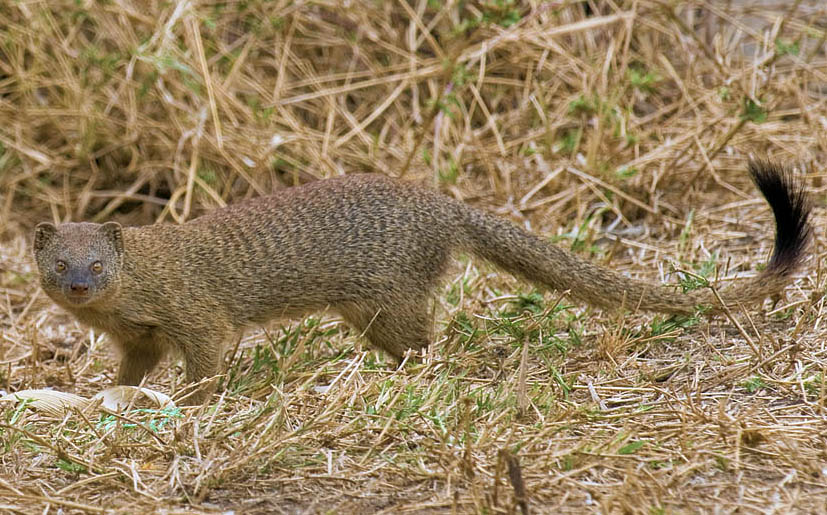
White-tailed Mongoose (Ichneumia albicauda):
Taxonomy:
- Kingdom: Animalia
- Phylum: Chordata
- Class: Mammalia
- Order: Carnivora
- Family: Herpestidae
- Genus: Ichneumia
- Species: Ichneumia albicauda
Brief Information:
- The White-tailed Mongoose, scientifically known as Ichneumia albicauda, is a species of mongoose found in sub-Saharan Africa.
- It is characterized by a grizzled grayish-brown coat with a distinctive white tip at the end of its tail, from which it gets its common name.
- White-tailed Mongooses have a sleek and elongated body, with a pointed snout and relatively large ears.
- They are primarily nocturnal, being more active during the night.
- Their diet includes a variety of prey, such as insects, small mammals, birds, reptiles, and eggs.
- These mongooses are known for their agility and ability to climb trees.
- They may live solitarily or in small family groups, and they are territorial in nature.
- White-tailed Mongooses are adaptable and can be found in a range of habitats, including savannas, woodlands, and grasslands.
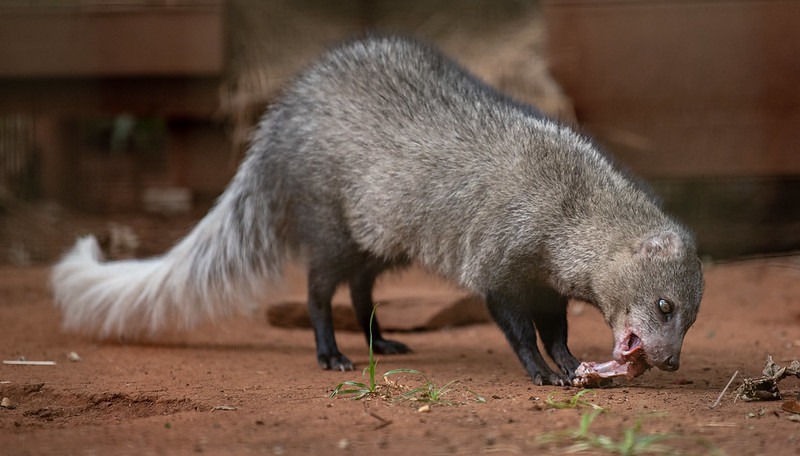
Banded Mongoose (Mungos mungo):
Taxonomy:
- Kingdom: Animalia
- Phylum: Chordata
- Class: Mammalia
- Order: Carnivora
- Family: Herpestidae
- Genus: Mungos
- Species: Mungos mungo
Brief Information:
- The Banded Mongoose is a species of mongoose found in central and eastern Africa.
- They are named for the dark bands or stripes across their backs, which are more pronounced in younger individuals and tend to fade as they age.
- Banded Mongooses have a robust and compact build, with a pointed snout and a long tail.
- They are highly social animals and live in colonies, which can consist of several dozen individuals.
- These colonies are organized in a hierarchical structure, with a dominant breeding pair at the top.
- Banded Mongooses are diurnal, being most active during the day, and they spend a significant amount of time foraging for food.
- Their diet includes a variety of prey, such as insects, small mammals, birds, and reptiles.
- They are known for their cooperative behavior in hunting and foraging, and they use communal dens for shelter and raising their young.
- Banded Mongooses are adaptable and can be found in various habitats, including savannas, woodlands, and grasslands.
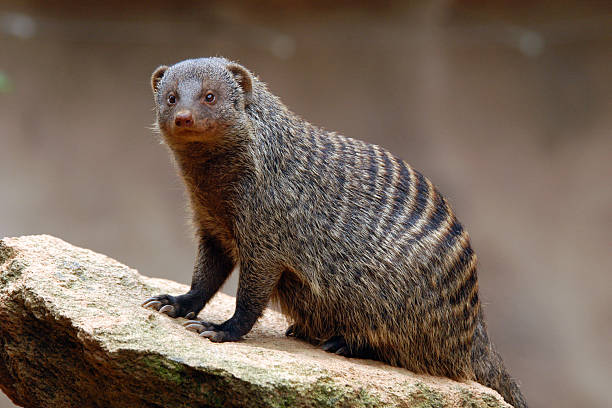
Dwarf Mongoose (Helogale parvula):
Taxonomy:
- Kingdom: Animalia
- Phylum: Chordata
- Class: Mammalia
- Order: Carnivora
- Family: Herpestidae
- Genus: Helogale
- Species: Helogale parvula
Brief Information:
- The Dwarf Mongoose is the smallest mongoose species and is found in parts of East and Southern Africa.
- They have a slender and elongated body with short legs, a pointed snout, and a long tail.
- The fur of the Dwarf Mongoose is typically grizzled grey or brown, and they often have dark patches around their eyes.
- Dwarf Mongooses are highly social and live in groups known as troops. These troops consist of related individuals, and they work together for various activities, including foraging and raising young.
- They are diurnal and spend a significant portion of their day foraging for food, which primarily includes insects, small mammals, reptiles, and birds.
- The Dwarf Mongoose is known for its agility and ability to climb trees and structures.
- They use termite mounds and other burrows for shelter and often have multiple den sites within their home range.
- Troops of Dwarf Mongooses are territorial and will defend their territory against other groups.
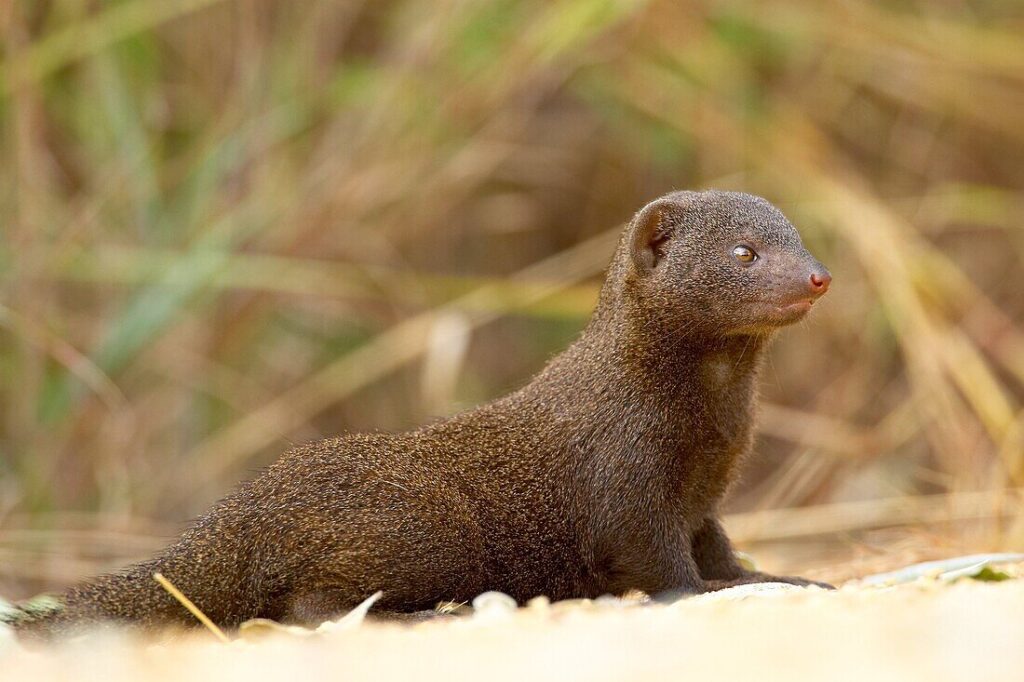
Stripe-necked Mongoose (Herpestes vitticollis):
Taxonomy:
- Kingdom: Animalia
- Phylum: Chordata
- Class: Mammalia
- Order: Carnivora
- Family: Herpestidae
- Genus: Herpestes
- Species: Herpestes vitticollis
Brief Information:
- The Stripe-necked Mongoose, also known as the Common Mongoose or the Brown Mongoose, is a species of mongoose found in South Asia.
- It is characterized by a sleek and elongated body, a pointed snout, and a long tail.
- The fur of the Stripe-necked Mongoose is typically brown or grey, with a distinctive dark stripe running along its neck and back.
- They are primarily terrestrial but are also capable climbers and swimmers.
- Stripe-necked Mongooses are opportunistic feeders, with a diet that includes insects, small mammals, birds, reptiles, and eggs.
- They are known for their agility and are skilled hunters, able to tackle venomous snakes.
- These mongooses are crepuscular, meaning they are most active during dawn and dusk.
- They are generally solitary or found in small family groups.
- The Stripe-necked Mongoose plays a role in controlling pest populations, making it beneficial in agricultural areas.
